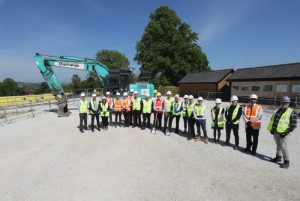According to Home Office statistics there were 33,180 house fires in the UK in 2020/21, causing 311 fire-related deaths. Cooking appliances are the leading cause of house fires, followed by electrical wiring/plugs and domestic appliances. With smoke inhalation being the primary cause of death in a building fire, taking as little as 2-10 minutes to cause fatality, it is important for construction companies to consider maintenance and fire stopping measures when designing and building commercial and residential properties. Over 60% of fire fatalities this year occurred in people aged over sixty, largely due to mobility issues preventing them from exiting the building quickly enough. The recent changes to Fire Safety (England) Regulations 2022 as a result of the Grenfell Tower enquiry has forced the construction sector to evaluate building materials and fire stopping methods in construction to find ways to slow down or prevent the spread of fire.
In this article, with support from Project Four Safety Solutions, Key Account Manager Tom Woolley explores what these new measures mean for the future of the Construction Industry.
Changes to The Fire Safety (England) Regulations
On 14th June 2017, an electrical fire spread rapidly throughout a 24-storey block of flats in West London killing 72 people and seriously injuring a further 74 occupants. The highly flammable exterior cladding on the Grenfell Tower block was found to have been a direct cause in aiding the dangerously fast combustion of the building and forced the Government to conduct urgent fire safety tests on similar high-rise cladding systems.
Following an independent review of building regulations and fire safety standards, the Government announced in June 2022 a set of changes which will come into force in January 2023 to ensure clear rules for the design and construction of workplaces and the common parts of all multi-occupied residential building developments. Devised to satisfy recommendations from Phase One of the Grenfell Tower Inquiry, the changes to The Fire Safety (England) Regulations 2022 are being laid under article 24 of the Fire Safety Order 2005, to strengthen the availability of information relevant to fire and rescue services. The key changes include:
• New residential buildings over 11m tall must include a secure information box that will give fire and rescue services access to information about the building in the event of a fire.
• New residential developments over 18m tall must incorporate an Evacuation Alert System to help fire and rescue services inform residents of a change in evacuation strategy during an incident.
• Stricter standards for external wall materials on new medium-rise blocks of flats have been introduced following the ban on the use of combustible materials in and on the external walls of new developments over 18m, hospitals, student accommodation buildings, boarding school dormitories, hotels, and hostels in England.
• A ban on the use of Metal Composite Material (MCM) panels with unmodified polyethylene (PE) core on all new buildings of any height.
• New statutory guidance to restrict the combustibility of materials used in and on the external walls of residential buildings between 11-18m in height, ensuring lower risk developments meet safety standards and designers and developers have the flexibility to use environmentally friendly materials.
Building Regulations 2019 & The Building Safety Act 2022
There are statutory requirements under Building Regulations 2019 Part B to use fire stopping methods in all refurbishment and new build construction projects. Building contractors have a responsibility to ensure adequate means of escape, reduce fire spread with consideration of materials used for floors, ceilings and walls, structural fire protection and fire service access. Keeping fire stopping records is a legal requirement for contractors and is important not just to ensure safety legalities are adhered to but also to prevent the loss of life from fire related incidents and loss of reputation and hefty fines.
The Building Safety Act introduced by the Government in April 2022 gives residents and homeowners more protection so that homes across the country are safer. Described as delivering ‘far-reaching protections for qualifying leaseholders from the costs associated with remediating historical building safety defects, and an ambitious toolkit of measures that will allow those responsible for building safety defects to be held to account’ it will be overseen by three new bodies – the Building Safety Regulator, the National Regulator of Construction Products and the New Homes Ombudsman. The Act will create a transparent and proportionate framework for the design, construction, and management of safer, high-quality homes for the future. Strengthening the construction products regulatory regime, the new requirements will make sure all construction products on the UK market are safe and fit for purpose, with a National Regulator for Construction Products to monitor and enforce this. A new developer tax and a levy on developers will ensure that industry contribute to rectifying the mistakes of the past, and a Grenfell Tower incident is never repeated.
What can construction companies do to implement fire stopping methods?
Fire stopping is also known as compartmentation and is an essential element of passive fireproofing. It refers to the practice of filling openings and joints between walls and floors with fire-resistant material, impeding the spread of fire between ‘compartments’ inside a building. There are many methods, materials, and products used for fire stopping. The most popular include:
• Fire Sleeves: specifically designed to seal the gaps around pipes and cables which pass through various compartments throughout the building, fire sleeves expand rapidly to fill the space preventing smoke or fire passing through to the next area.
• Fire Collars: expand under the high temperature caused by a fire to support fire resistance alongside other fire stops and prevent gasses or flames from spreading.
• Fire Covers: designed to stop fires along ceilings, the cover will immediately expand internally from heat caused by fire and fill an entire space with a fire-resistant, insulating char.
• Fire Sealants: are gap fillers made from fire stopping materials that expand to prevent fire and smoke from spreading through spaces such as door frames or window cavities.
The Importance of Building Maintenance and Technology in Fire Prevention Measures
Each year there are approximately 22,000 fires in workplaces around the UK. The Regulatory Reform (Fire Safety) Order 2005 stipulates that a responsible person must ‘take such general fire precautions as will ensure, so far as is reasonably practicable, the safety of any of his employees.’ As a legal requirement that all non-residential premises must have someone in charge of fire prevention, this responsibility ordinarily falls to Facilities Management. Their role of ensuring the building and its content is well maintained and in good working order is critical in ensuring fire prevention.
Historically facility management has been a very manual task. Performing floor walks, inspections, identifying hazards, performing safety checks, testing fire doors and evacuation procedures and checking fire equipment such as smoke detectors, and fire extinguishers. Not to mention keeping up to date with training and updated regulations. However, the increasingly popular use of digital technology is set to make facilities management more efficient and streamlined in the future. Digital fire risk assessments, fire safety procedures and ticketing software ensure that the right personnel have access to important information, it is updated regularly and on time and maintenance issues can be reported and rectified swiftly.
The use of Digital Twin Technology in designing buildings will revolutionise the efficiency, management, and safety of buildings in the future. This ability to create a virtual replica of a potential or actual building, and the processes, people, systems, and devices within the space, means that a test environment can be set-up to identify and eradicate any problems before construction starts and the building becomes operational. It can be used to improve safety aspects of the design and improve the building’s efficiency and Environmental, Social and Governance (ESG) ratings. Using artificial intelligence Digital Twin Technology can identify failures before they occur, find solutions to improve operations and maintenance, and provide information about the building to such a detailed level that the facilities team can re-order the exact specification of a replacement lightbulb.
Making Buildings of the Future Safer
Public sector organisations and the construction industry have a responsibility to ensure buildings are safe. Their design and construction play an integral role in the safety, efficiency, and sustainability of the space. Maintenance and fire prevention are key considerations for ensuring any domestic or non-domestic environment is fit for purpose and adequately protected from fire for the safety of its occupants.
As a dedicated UK procurement framework, Procure Partnerships has the necessary expertise to support both public sector bodies and our supply chain partners when new or updated laws and policies impact the construction sector, and we offer expert help and guidance throughout the procurement process as part of our national framework.
Connor McIlroy Project Four Safety Solutions Limited, commented: ‘The Building Safety Act 2022 since it’s emergence in May 2018 and then post royal-assent on 28th April 2022 has altered the landscape of the Construction Industry and has aimed at driving standards and ensuring compliance with fire safety critical aspects of the built environment as a response to the tragedy of the Grenfell Tower fire. At Project Four, we embraced the Act and immediately starting working with industry leaders and the Building Safety Regulator themselves to begin to implement process and strategy with our Developer, Designer and Contractor Clients in preparation for compliance with The Building Safety Act.
We recommend all businesses in the Built Environment sector review their process, engage and embrace the requirements of The Building Safety Act 2022 and focus on upskilling and increasing the competency of their teams in readiness for ever-changing legislation. Project Four have undertaken a number of Strategic Gap Analysis exercises across the industry to ensure our Clients are ready for change.’
Click Here To Download a Procure Partnerships Framework User Guide
Twitter
Linkedin



